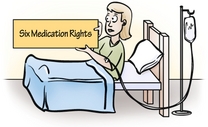Chapter 11
Pharmacology, Medication, and Intravenous Calculation Questions

 Pharmacology: General Guidelines to Follow
Pharmacology: General Guidelines to Follow
1. Medication absorption, distribution, metabolism, and excretion are affected by age and physiological processes; the older client and the neonate and infant are at greater risk for toxicity than an adult.
2. Many medications are contraindicated in pregnancy and during breastfeeding.
3. Antacids are not usually administered with medication because the antacid will affect the absorption of the medication.
4. Grapefruit juice is not usually administered with medication because it contains a substance that will impede the absorption of the medication.
5. Enteric-coated and sustained-release tablets should not be crushed; also, capsules should not be opened.
6. Nursing interventions always include monitoring for intended effects, side effects, adverse effects, or toxic effects of the medication.
7. Nursing interventions always include client education.
8. The nurse or client should never adjust or change a medication dose, abruptly stop taking a medication, or discontinue a medication.
9. The nurse may withhold a medication if he or she suspects that the client is experiencing an adverse or toxic effect of a medication; the nurse must immediately contact the health care provider if either of these effects occurs. The nurse may also withhold the medication if specific parameters are prescribed and withholding the medication is indicated based on these parameters.
10. The client needs to avoid taking any over-the-counter medications or any other medications, such as herbal preparations, unless they are approved for use by the health care provider.
11. The client needs to know how to correctly administer the medication.
12. The client needs to be aware of the side effects and adverse effects of medications and how to check his or her own temperature, pulse, and blood pressure.
13. The client needs to take the prescribed dose for the prescribed length of therapy and understand the necessity of compliance.
14. The client needs to avoid consuming alcohol and to avoid smoking.
15. The client should wear a Medic-Alert bracelet if he or she is taking medications such as, but not limited to, anticoagulants, oral hypoglycemics or insulin, certain cardiac medications, corticosteroids and glucocorticoids, antimyasthenic medications, anticonvulsants, and monoamine oxidase inhibitors.
16. The client needs to follow up with a health care provider as prescribed.
The following sample pharmacology question illustrates how these general pharmacology guidelines may be helpful.
Pharmacology: Assessment/Data Collection Guidelines
 Pharmacology: Assessment/Data Collection Guidelines to Follow
Pharmacology: Assessment/Data Collection Guidelines to Follow
1. Always assess for client allergies or hypersensitivity to a medication.
2. Always assess the client for existing medical disorders that are contraindicated with the administration of a prescribed medication.
3. Always assess for potential interactions related to the medication.
4. Always check pertinent laboratory results.
5. Always check the client’s vital signs, particularly if medications such as antihypertensive or cardiac medications are being administered.
6. Always assess the client for intended effects, side effects, adverse effects, or toxic effects of the medication.




